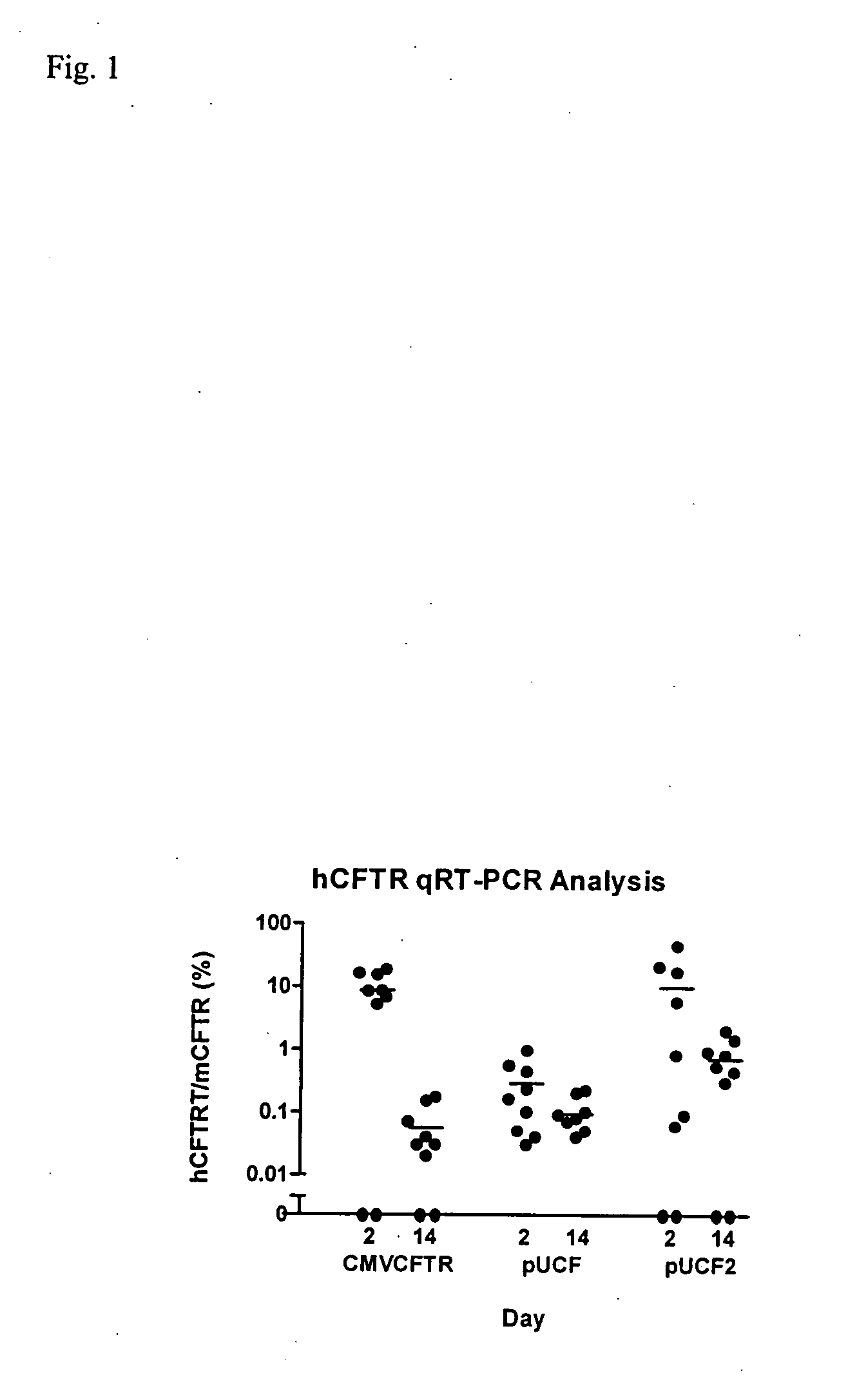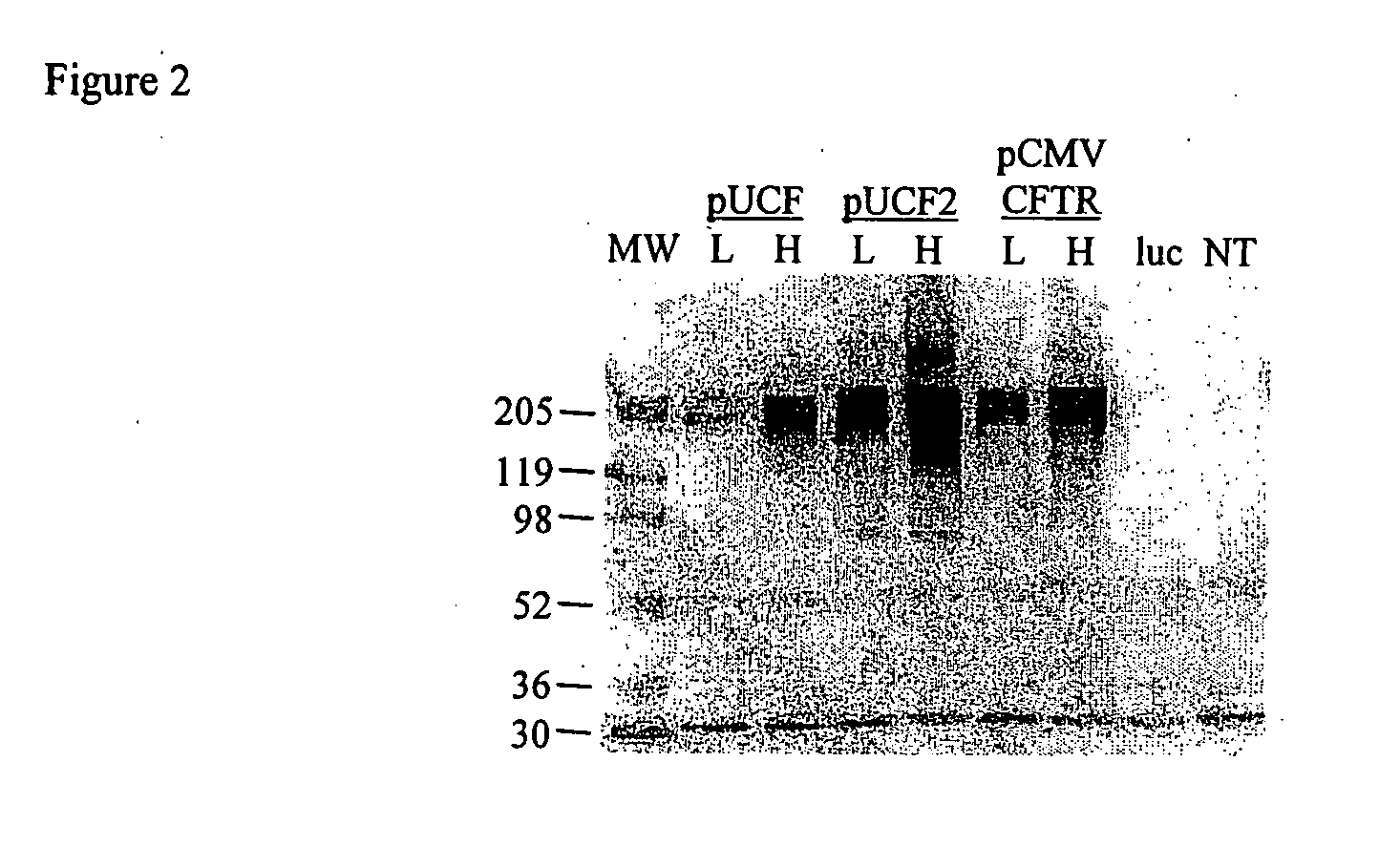Codon optimized cftr
a technology of cftr and codon, applied in the field of cystic fibrosis, can solve the problems of recurrent lung infections, subsequent structural lung damage, eventual respiratory failure, etc., and achieve the effect of increasing the expression of an mrna
- Summary
- Abstract
- Description
- Claims
- Application Information
AI Technical Summary
Benefits of technology
Problems solved by technology
Method used
Image
Examples
example 1
Evaluation of Codon-Optimized hCFTR cDNA
[0030]Since codon-optimization of the hCFTR sequence might improve translation efficiency in transfected lung cells, the following hCFTR DNA was synthesized. Presented below is an analysis of the natural hCFTR cDNA and a codon-optimized hCFTR sequence. The latter also was CpG-island depleted except for a single CpG island in the 3-prime region. In other versions, this single CpG island was removed (no CpG islands)
Natural hCFTR cDNA: CpG islands = 58Codon Usage Table 1Amino AcidsRanks (most -> least)Single-letterThree-letter123456FPheTTC = 38TTT = 47LLeuCTG = 37CTC = 24CTT = 32TTG = 34 TTA = 37CTA = 19SSerAGC = 24TCC = 17TCT = 30TCA = 29AGT = 19TCG = 4YTyrTAC = 18TAT = 22*TerTGA = 0TAA = 0TAG = 1CCysTGC = 10TGT = 8WTrpTGG = 23PProCCC = 11CCT = 20CCA = 13CCG = 1HHisCAC = 14CAT = 11QGlnCAG = 31CAA = 36RArgAGA = 37AGG = 16CGG = 8CGC = 5CGA = 9CGT = 3IIleATC = 36ATT = 50ATA = 33MMetATG = 38TThrACC = 15ACA = 33ACT = 3ACG = 32NAsnAAC = 29AAT = 25KLys...
example 2
Evaluation of Expression Vectors Encoding Natural hCFTR cDNA
[0032]We first evaluated hCFTR mRNA levels in mice dosed with our prior CMVCFTR clinical trial plasmid, with lung harvests at days 2 and 14 (FIG. 1). Of 9 dosed mice, 2 had no hCFTR signal on both days 2 and 14, consistent with ‘missed doses’ in these intranasal (TN) dosed mice or true negatives. The average hCFTR / mCFTR ratio for all data on day 2 was 8.7% (+ / −6.7%, SD) and by day 14 this ratio had fallen to 0.06% (+ / −0.06%). This study was repeated with a derivative of the pUL plasmid (pUCF) with luciferase replaced by the same CFTR cDNA used in the CMVCFTR plasmid. Although luciferase activity in pUL is comparable to our analogous CMVluc plasmid, hCFTR expression levels were lower than pCMVCFTR on day 2, with a hCFTR / mCFTR ratio of 0.28% and falling to 0.09% by day 14. This result with pUCF was disappointing and could be due to several factors, as discussed below.
[0033]It is appreciated that multiple factors may be involv...
example 3
Evaluation of Expression Vector Encoding Synthetic hCFTR DNA
[0034]pUCF2 was dosed intranasally (IN) into Balb / C mice and lungs were harvested at days 2 and 14 for evaluation of CFTR mRNA. As shown in FIG. 1, pUCF2 generated a hCFTR / mCFTR ratio on day 2 of 9.8% (+ / −15%, SD) which fell to 0.72% (+ / −0.67%) on day 14. The mean day 2 signal for pUCF2 is comparable to pCMVCFTR and likely is achieving a biologically significant level of CFTR expression, with a hCFTR / mCFTR ratio >5-6%. Although CFTR mRNA expression was not maintained, the day 14 hCFTR / mCFTR ratios for pUCF2 were significantly higher than for pCMVCFTR and pUCF, which is a first step in prolonging CFTR expression. Interestingly, the day 2 expression for pUCF2 was considerably higher (35-fold) than for pUCF, which appears related to CO-CFTR since both plasmids are nearly otherwise identical. This finding suggests that CO-CFTR cDNA is transcribed and / or processed more efficiently than natural CFTR cDNA in the context of this ve...
PUM
| Property | Measurement | Unit |
|---|---|---|
| Mass | aaaaa | aaaaa |
| Mass | aaaaa | aaaaa |
| Mass | aaaaa | aaaaa |
Abstract
Description
Claims
Application Information
 Login to View More
Login to View More - R&D
- Intellectual Property
- Life Sciences
- Materials
- Tech Scout
- Unparalleled Data Quality
- Higher Quality Content
- 60% Fewer Hallucinations
Browse by: Latest US Patents, China's latest patents, Technical Efficacy Thesaurus, Application Domain, Technology Topic, Popular Technical Reports.
© 2025 PatSnap. All rights reserved.Legal|Privacy policy|Modern Slavery Act Transparency Statement|Sitemap|About US| Contact US: help@patsnap.com



